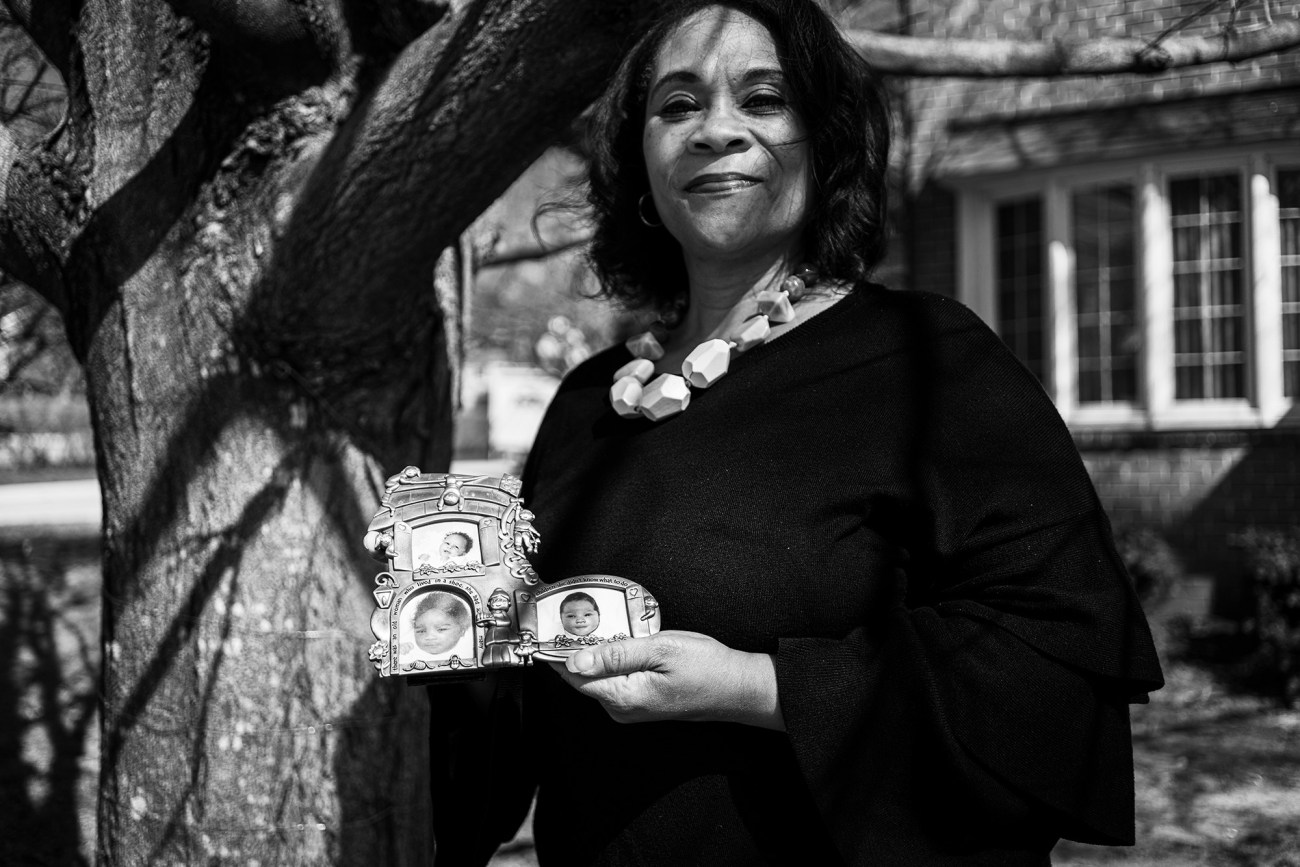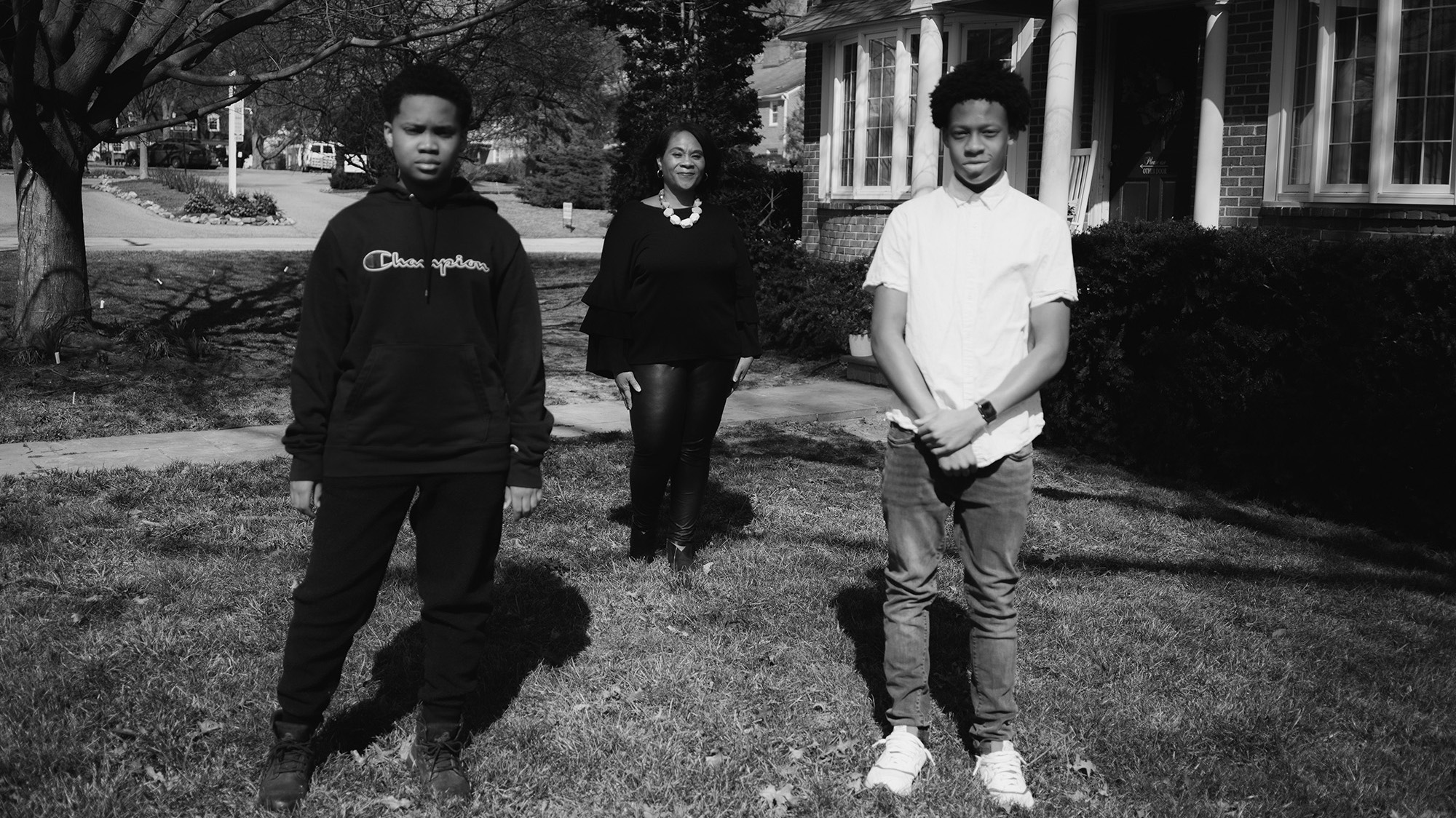In the spring of 2020, with Maryland’s stay-at-home order lifted, a new ritual was born on a cul-de-sac in North Baltimore’s affluent Homeland neighborhood. A group of moms gathered on Friday evenings to commiserate about the sudden pivot to remote learning. Seated in physically distanced chairs under a maple tree, Annette Anderson and her friends talked about the stresses of managing their own jobs while overseeing their children’s schoolwork. As summer arrived, the weekly conversations turned to speculation over the Baltimore City Public Schools plan for reopening in the fall. Other moms were clearly ready to turn their children back over to full-time teachers. But Anderson was a firm no.
The Black mother of three had watched her children blossom during the spring semester. Freed from transporting three teens—a sophomore, an eighth grader, and a seventh grader—to athletic games and extracurriculars, Anderson (no relation to me) was more engaged in their lives, and her children were thriving academically, more attuned to their online classes and more self-directed in their learning. She was also skeptical that Baltimore schools had figured out how to do in-person instruction safely. As the deputy director of the Johns Hopkins Center for Safe and Healthy Schools, she spends her days giving policymakers the tools they need to make evidence-based decisions. Conflicting research on safely reopening schools, coupled with a lack of direction from the federal level, told her it was better to sit this one out.
“At the same time that people were talking about reopening, we were seeing [COVID-19] case numbers go up astronomically,” she recalled. “There was no clear guidance. It was just, ‘Trust us, send the kids back, and it’ll be okay.’” When Anderson queried other Black families to see how they were feeling, she discovered she was not alone.
Few issues this year have been as rife with division and drama as the on-again, off-again efforts of school districts to restart in-person learning. President Biden vowed to open most public schools in his first 100 days—but his pledge was quickly scaled back to only a majority of elementary schools. Both Republican and Democratic governors have directed schools to open; teachers unions have balked at returning until staff is vaccinated; and parents across the political spectrum have protested and petitioned to resume in-person learning. Citing the need to reduce COVID-related learning gaps and provide working parents some relief, education systems sought to bring at least some younger students back to classrooms.
Amid the fierce debate, Black parents across the country have largely resisted the push to return to public schools. According to a December report from the Centers for Disease Control and Prevention, 62 percent of white parents strongly or somewhat agreed that school should reopen this fall, while less than half of Black parents agreed. In a Pew Research survey conducted in mid-February, Black adults were the most likely of all racial groups to worry about the health risks of reopening—80 percent of Black adults wanted kids to stay remote until teachers were vaccinated, for example, while only 51 percent of white adults felt the same.
And no wonder: The pandemic has dealt a disproportionately heavy blow to Black Americans. According to CDC data published in September, Black youth accounted for 29 percent of COVID-19 deaths among people under 21, twice the percentage for white youth. The federal agency also found Black children under 18 at a significantly higher risk of hospitalization—almost four times higher than white children and teens.
Families across racial and ethnic groups are worried about the risks of returning to classrooms. But what sets so many Black parents apart is the acute distrust underlying their doubts—doubts shaped by generations of racial discrimination and institutional inequality. The long history of racism in public schooling—from de facto segregation and funding inequities to the overpolicing of Black bodies—as well as the systemic racism that impedes access to and delivery of quality health care for Black people, permeates their thinking and actions. As districts try to salvage this school year and reset for the next one with ramped-up testing, reconfigured classrooms, and refurbished ventilation systems, the overarching and unanswered question remains: Will Black parents return?

In Central Harlem, community activist Tanesha Grant said the track record of the city’s Department of Education is abysmal, leaving her unconvinced that its schools are safe. “It’s very hard to trust anything that DOE says because, dealing with them as an education advocate, they lie a lot,” she said. Her 13-year-old son attends school in Manhattan’s predominantly Black and Latinx District 5, which has been marked by decades of neglect. Grant was not persuaded by the district’s pitch for in-person learning. After years of battling for equitable resources in one of the country’s most segregated school systems, the promises rang hollow.
“If they didn’t keep my children safe before COVID, why would I think that they would now?” she said. “All the pandemic has done is made a situation that was already horrible almost unbearable…These buildings are old and don’t have proper ventilation. They don’t have the supplies they need, and they don’t even have nurses.”
A noticeable race and class divide—between mostly white, affluent families and low-income communities of color—has surfaced in the discourse over opening schools. Yet Grant dismissed the argument made by some that schools should reopen for the sake of lower-income Black children whose academic progress is hindered by keeping them home. “There are single mothers out here teaching their children by themselves,” she said, noting the suddenness of white parents’ interest in equity. Grant knew that her son could work remotely; he just needed adequate technology. Well into November, some 60,000 New York City students were still waiting for devices to participate in remote learning. With many students in Harlem affected, Grant founded Parents Supporting Parents NY to supply laptops to Black families left unserved. The nonprofit has distributed more than 100 laptops this school year.
According to Pew’s findings, a majority of white adults say the prospect of students falling behind academically and the negative impact of school closures on students’ emotional well-being should weigh heavily in reopening decisions. But Black children’s parents, grandparents, and extended family members are dying from COVID, Grant said, and “no one’s even thinking about that. We’re all talking about learning. How is a child going to learn anything when they’re in constant grief?” She also rejected the notion—offered by the New York Times’ David Brooks and others—that Black parents choosing to stay remote are victims of fearmongering. “I know too many people that have died. I saw the bodies piled up in the back of the trucks,” Grant said, recalling the peak of the pandemic in April of last year when mobile morgues lined the city’s streets. “They’re insinuating that we’re ignorant…That’s just gaslighting.” The COVID risk to Black families is real, she stated, noting that many live in multigenerational households and get very different care when they go to the hospital. “We know our child could bring this home to us.”

Annette Anderson.
SHAN Wallace
Confronting the distrust of parents like Grant starts with acknowledging their lived experience. “You are coming up against the weight of 400 years of anti-Blackness and racialized caste-making in the United States,” said historian Dan Royles, an assistant professor at Florida International University who has studied and written on the intersection of race, science, and medicine. The historical roots of Black parents’ distrust can be traced to centuries of structural racism in the institution of public schooling. Educational apartheid has relegated Black children to underfunded and inferior schools from the emancipation of formerly enslaved people through today. Volumes of research reveal biased assumptions and beliefs about Black students’ intellect and potential. And the overwhelming dissatisfaction with the quality of schooling Black children receive is a matter of record: A 2017 survey found that 74 percent of Black parents and family members believe the education Black students receive is worse than the education delivered to white students. Entrenched racism is a longstanding and persistent feature of American public education.
It’s understandable that Black families would be wary of sending their children back to school, he said, when public policy decisions “at every level are made in ways that devalue Black life of all ages”—and, what’s more, when “science has been used to justify your oppression.”
Well-known stories of racist medical abuse, such as the Tuskegee Experiment—in which government researchers deliberately withheld penicillin from Black men to track the progression of untreated syphilis—and the case of Henrietta Lacks—in which a Black woman’s cells were taken without her consent and used in biomedical research—resonate in Black communities because medical mistreatment is an everyday phenomenon, Royles explained. “Sending your kids back to school might lead to someone in your household getting infected, and you also know that if they do, they’re likely to receive substandard care,” he said. Underpinning Black parents’ distrust is the fact that they won’t get “the same quality of treatment that white folks with COVID get,” he added. Schools should take the concerns of Black parents seriously rather than approaching them in a patronizing or transactional way—“‘What can I do to signal that I understand for this moment, so that you’ll do the thing that I want you to do?’” as Royles put it.
School districts have experienced a huge breakdown of trust with Black families and will need to put in a lot of energy and effort to coax them back, said Kayla Patrick, a senior policy analyst for the Education Trust, a national advocacy group focused on historically underserved students. This will involve more than delivering COVID-safe buildings. “‘Safely’ means making sure that there’s a positive environment, that Black students feel welcome, and that they are treated with respect,” she said, referring to recent incidents of school resource officers assaulting Black children on reopened school campuses.
Particularly in school systems where Black students make up a sizable portion of the enrollment, the fervor to reopen schools despite Black families’ reluctance sends the unspoken message that schools aren’t listening to the needs of many parents and children. As a case in point, Grant cited parents’ unmet demands to improve remote learning in New York City with higher-quality devices and more mental health services. “Black children are not a monolith,” Patrick said. She emphasized that there are Black children who may need in-person learning support, “but there are many Black children who are doing just fine” in this moment. “We need to make sure that we are giving each group of Black children exactly what they need.”

Yolanda P. Corbett, a Black mother in Washington, DC, has watched the city’s reopening preparations, and she worries that she and her three sons—ages 6, 13, and 14—will be penalized for her choice not to participate in in-person schooling. Will DCPS make adjustments for families like hers? “Where will the staff come from to give us that individual attention when our children are not understanding the work?” she asked. “Will the message be that in-person is the norm, we gave you an option, and you could’ve gotten better service if you came into the building?”
The apprehensions are justified. Corbett lives in Ward 7, a high-poverty, majority-Black section of DC that is routinely overlooked and underserved—what she described as “a discarded population.” The single mom’s decision to stay remote—despite the demands of work and educating her youngest—was informed by a yearslong struggle to revamp the neighborhood’s aging schools. Black parents organized and complained about the lack of air conditioning in the schools, lobbying every budget cycle for more funding to improve HVAC units and other facilities. They were continually thwarted by other budgetary demands.
Given that her two youngest children are severely asthmatic, Corbett was unpersuaded by the arguments for returning. Parents “have a clear understanding that you couldn’t have possibly fixed all of these issues,” she said. “There’s not enough solid evidence to see why, as an organizer, I should tell parents to really consider the in-person model.”
At the same time, she wrestles with virtual schooling for her oldest son, who is autistic, and for whom remote instruction is difficult. “I don’t want him to fail,” she said, but “I do have just as much concern for his experience of being in-person as I do for my other two children.” Conflicted about his going back to a school building once a week, she admits, “I just don’t know where I fall.”
In the Anderson household, the children are on the fence about returning in September—while they miss their friends, they’ve enjoyed the flexibility and safety of being home. School districts must reckon with how the pandemic has shifted what Black families expect and will accept from their public education systems.
Black parents want to be heard, and beyond COVID protocols, they are now saying, “Fix the buildings, fix the school culture, fix the curriculum,” Anderson said. “That Fannie Lou Hamer spirit of ‘I’m sick and tired of being sick and tired’ is what’s starting to rear its head.”
















